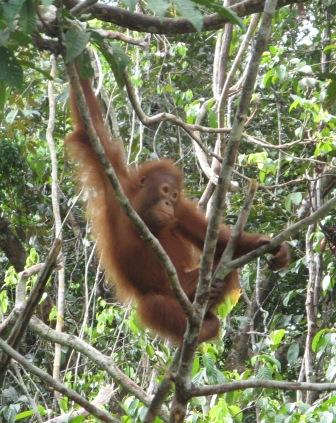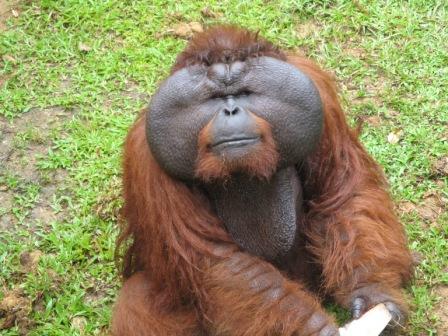
Orangutans are the only one of the great apes found outside Africa (aside from humans). In the past they were found throughout southern Asia but are now restricted to the islands of Borneo and Sumatra with distinct species on each. Widespread destruction of their habitat in recent years (particularly with the spread of palm oil plantations) has seen the numbers of orangutans decimated. There are likely to be less than 20,000 left in the wild, with the Bornean orangutan listed as endangered and the Sumatran orangutan now critically endangered.

Orangutans are one of the most iconic and admired species in the world and an encounter with these beautiful and intelligent creatures is a highlight of any trip to Borneo or Sumatra. The decreasing orangutan numbers, the dense rainforest foliage and their solitary nature makes it very difficult to see orangutans in the wild, but you may be lucky enough to spot one on guided treks through the rainforest. The best chance of seeing orangutans however is at rehabilitation centres such as Semenggoh in Sarawak and Sepilok in Sabah – here animals rescued from logging sites are rehabilitated and prepared for release back into the wild.
| Semenggoh Orangutan Centre | |
|---|---|
Like Sepilok in Sabah, Semenggoh Orangutan Centre near Kuching in Sarawak helps to rehabilitate injured and orphaned orangutans before releasing them into the wild. Massive destruction of their habitat in recent years with the spread of palm oil plantations has had a devastating effect on orangutan numbers and centres like these are helping to preserve this beautiful and intelligent creature, the only great ape found outside Africa. At Semenggoh, you can watch semi-wild orangutans come out of the forest during feeding time, perhaps your best opportunity to see these amazing animals. | |
| Batang Ai | |
|---|---|
Perhaps the true highlight of a trip to Borneo is travelling deep into the Borneo rainforest and staying there with traditional tribes. Of the options available, Batang Ai, east of Kuching, is one of the best. This area is home to the Iban tribe, the largest and most vibrant of Sarawak's 22 tribal groups, who live with extended family groups in traditional longhouses by rivers on the edge of the jungle. In times past the Iban used to be known as head-hunters but today they live through fishing and ecotourism. Trekking through the jungle can be strenuous and humid but is a perfect opportunity to experience unspoilt wilderness and search elusive orangutans and or their nests. Bathing in the rivers or at Enseluai Waterfall offers ideal relaxation after trekking, in addition to learning about Iban customs and trying their rice wine. | |
| Sepilok Orangutan Rehabilitation Centre | |
|---|---|
Sepilok Orangutan Rehabilitation Centre was set up in 1964 and covers over 4,000 hectares. It is one of only three orangutan sanctuaries in the world, designed to rehabilitate injured and orphaned orangutans and teach them the skills required for them to survive in the wild. There has been massive destruction of the rainforests of Borneo and Sumatra in recent years to make way for palm oil plantations and this has had a devastating effect on orangutan habitat and numbers. Orangutans are the only great ape found outside Africa and are beautiful and intelligent creatures who captivate all those who see them. Being solitary and shy animals, it is very difficult to spot orangutans in the wild, so centres like Sepilok offer a great opportunity to see these apes swinging through the trees at feeding time. | |
| Sukau Rainforest | |
|---|---|
The Kinabatangan River is the longest in Borneo and as it meanders through the Sukau Rainforest it creates a flood plain that makes it an excellent environment for wildlife viewing. River cruises along the Kinabatangan enable spotting of proboscis and leaf monkeys, orangutans, Bornean gibbon, Asian pygmy elephants, long tailed macaques, sun bears, clouded leopards and barking deer, as well as over 200 bird species including frogmouth, hornbill, egret and oriole. | |
| Danum Valley | |
|---|---|
The Danum Valley is the largest protected lowland rainforest area in Asia, measuring some 430 km². It is home to 274 bird species and 110 mammal species, many of which are rare and endangered. From a base at the Borneo Rainforest Lodge, there are many trails through the jungle that allow you to look for orangutans, giant flying squirrels, gibbons, bearded wild boars, flying frogs, Asian elephant and the extremely endangered Sumatran rhinoceros. Night drives may enable spotting of nocturnal species such as civet, sambar deer, leopard cat, slow loris or clouded leopard. | |
Travel to Orangutans
Organised group tours: Click here to see 4 tours to Borneo which may include Orangutans.
 Wildlife Finder |
Information and archive footage of the orangutan |  |
Learn about and support conservation efforts to protect the orangutan |
|---|






